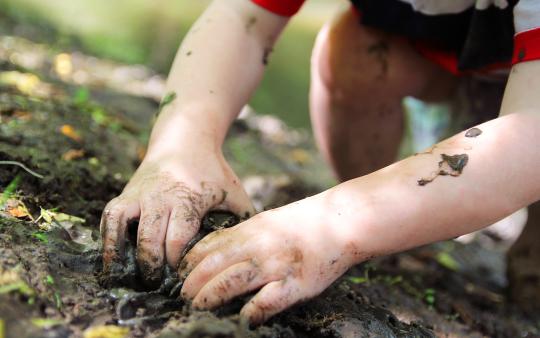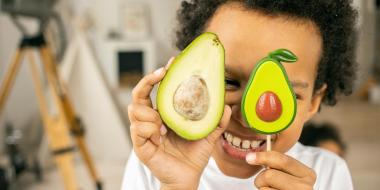As a new parent, I was terrified of germs—and overwhelmed by advice. Don't put the binky in your mouth before handing it back. Sterilize all bottles and brushes. Don't double dip the spoon in the baby food, and definitely DON'T. LET. HIM. EAT. THAT! While proper sanitation and hygiene are vitally important, I had to learn to let go and allow my child to build his immune system by getting dirty. Society and marketers teach us to focus on removing all dirt and microbes, but many health practitioners believe that in avoiding all bacteria, we've gone overboard in practices that damage both our health and our environment.
Germaphobia craze!
We’re surrounded with products that keep us away from dirt: shopping cart covers, antibacterial soaps, hand sanitizer, disposable plates, and ultra-pasteurization for almost everything. North America has become a hub for mysophobia or molysmophobia: a society terrified of dirt.
When did germaphobia become so popular? It’s not a new thing. Infections have long been a legitimate societal fear. A possible contributor to our modern germaphobia may be an incomplete understanding of germs and bacteria. As technology has progressed, we have better grasped that microscopic agents can make us sick, but we haven’t evolved a precise understanding of which of these actually cause illness. This gap in knowledge has caused a wholesale avoidance of all things “dirty” and this may, in fact, be harming our health.
Stop the antibacterial madness!
Experts note that a little dirt helps create a healthy immune system, and the absence of these gentle immune builders can have long-term health consequences. A privation of dirt has long been correlated with an increase in allergies, with one of the first notations on the subject reported the British Journal of Homeopathy way back in 1862! While we have gained the benefits of sanitation against pathogens like E. Coli and salmonella by simply cooking our food thoroughly, and can decrease our risk of contracting infectious diseases by washing our hands, it seems in other ways we’ve also reduced exposure to bacteria that help safely build immune systems in our kids. The CDC notes the percentage of children in the United States with a food allergy rose 50 percent between 1997–1999 and 2009–2011, with income and education level correlating with the highest rates of allergy. Sometimes referred to as a “disease of affluence”, this increase suggests that lifestyles where there is decreased exposure to pets and livestock, increased access to and overuse of antibiotics, and excessive hygiene practices habitually using germ-killing commercial products might be depriving children of exposure to beneficial bacteria.
Avoiding dirt also means avoiding nature, and contact with nature is good for your health, providing a multitude of physical, psychological, and cognitive benefits. The Japanese have a term for getting outside to experience dirt and nature for your well-being called Shin-rin-yoku, or Forest Bathing. Benefits of nature on mental health may include:
- Improved memory and concentration
- Decrease of symptoms associated with ADHD
- Lessened stress and anxiety
- Improvement in symptoms of PTSD
- Better sleep
There is an unsurprising link between brain and body health, and one of the most well-known links includes the health of the gut microbiome. Noted microbe researchers from the Rob Dunn Lab have been studying how the microbes we are (or are not) exposed to in our home environment may directly influence our health and wellbeing. This is backed up by additional studies showing that microbes in the soil can help combat depression. The Smithsonian further notes that there is a strong indication that a “lack of normal gut microbes early in life disturbs the central nervous system.”
Get the good dirt in!
While scientific research definitely supports getting dirty, it’s important to note that not all dirt is equal. For example, sand from construction sites may be host to many different chemicals used in the building process or be contaminated with tiny shards of glass or bits of metal. For your sandbox, opt for “play sand”, which can be found at your local home improvement store and should be free of the most dangerous contaminants.
In addition to avoiding dirt from commercial sites, be wary of contamination from local animals. Don’t let your garden (or sandbox) become a litter box for neighborhood cats, and treat any areas that become raccoon latrine sites in order to avoid roundworm (Baylisascaris procyonis). If you have further concerns about the quality of your soil at home, consider having it tested to rule out extra environmental contaminants like lead.
Eventually, dirt will be washed off, but don’t overdo bathing. While hand washing with regular soap and warm water can and should be done frequently, a full bath need not happen each day. Focus on cleaning the sticky, the stinky, and the “Yikes! Don’t get that on the couch!” kind of dirt. For everything else, a proper run through the sprinkler might just be clean enough, leaving some healthy, immune-building dirty behind.
Similarly, cleaning your home with antibacterial disinfectants full of toxic chemicals is largely unnecessary. Most everyday dirt and messes can be taken care of with warm, soapy water. Some food remnants, such as the juice from meat, may need a little extra treatment, but many of these microbes—such as Listeria and E.coli—can be destroyed with simple vinegar or hydrogen peroxide.
Nowadays I let a little dirt happen. It’s entirely possible to practice good hygiene while still getting dirty. Do follow expert guidelines on what is safe at what age and use proper food storage and preparation techniques. But don’t stress if your little one samples a bit of that good organic garden dirt, or if you drop the binky and don’t boil it after. Consider yourself a good parent because science says a little dirt may actually cure what ails us!






